Initial release date 1991 Genre Platform game | Mode(s) Single-player | |
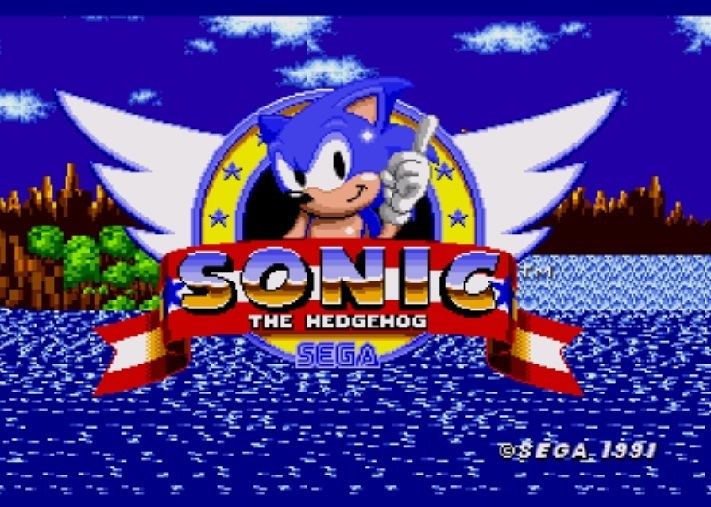 | ||
Artist(s) Naoto OhshimaJina IshiwatariRieko Kodama Similar Sonic the Hedgehog games, Sega games, Platform games | ||
Sonic the Hedgehog is a platform video game developed by Sonic Team and published by Sega for the Sega Genesis console. The game was first released in North America, Europe, New Zealand and Australia in June 1991, and in Japan the following month. The game features an anthropomorphic hedgehog named Sonic in a quest to defeat Dr. Eggman, a scientist who has imprisoned animals in robots and stolen the magical Chaos Emeralds. Sonic the Hedgehog's gameplay involves collecting rings as a form of health and a simple control scheme, with jumping and attacking controlled by a single button.
Contents
- Plot
- Gameplay
- Background and character design
- Programming and prototyping
- Music
- Packaging and release
- 8 bit version
- Sonic the Hedgehog Genesis
- Compilation releases
- Downloadable releases
- Reception
- Legacy
- References
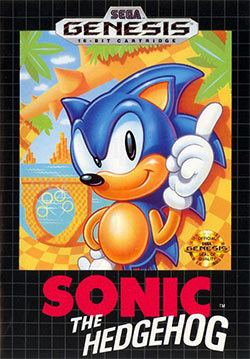
The game's development began in 1990, when Sega ordered its AM8 development team to create a game featuring a mascot for the company. After considering a number of suggestions, the developers decided on a blue hedgehog with spikes along his head and spine and renamed themselves "Sonic Team" to match their character. Sonic the Hedgehog, designed for fast gameplay, was influenced by the games of Super Mario series creator, Shigeru Miyamoto. Sonic the Hedgehog uses a novel technique that allows Sonic's sprite to roll along curved scenery, which originated in a tech demo created by the game's programmer, Yuji Naka.
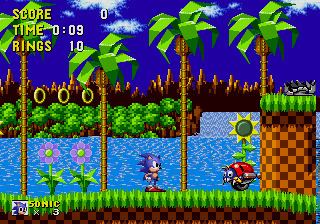
The game was well received by critics, with praise given to its visuals, music, and gameplay. The game was also commercially successful, establishing the Genesis as a key player in the 16-bit era and allowing it to compete with Nintendo and their Super Nintendo Entertainment System console. The game has been ported a number of times, and inspired several clones, a successful franchise, and adaptations into other media.
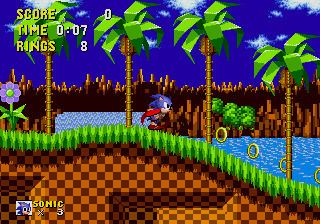
Plot

In an attempt to steal the six Chaos Emeralds and harness their power, the game's antagonist, Dr. Ivo Robotnik, has trapped the animal inhabitants of South Island in aggressive robots and stationary metal capsules. The player controls Sonic, who aims to halt Robotnik's plans by freeing his animal friends and collecting the emeralds himself. If the player collects all the Chaos Emeralds and completes the game, a reward ending sequence is shown. If not all the emeralds are collected, Robotnik taunts the player while juggling any of the Chaos Emeralds not collected by the player.
Gameplay
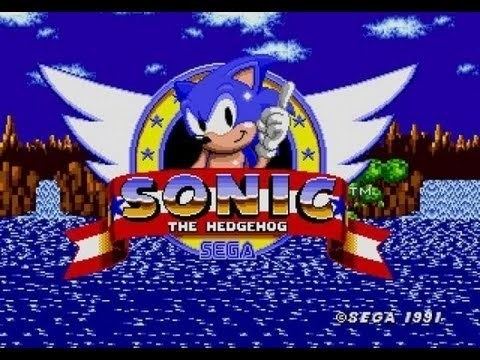
Sonic the Hedgehog plays as a 2D side-scrolling platformer. The gameplay centers around Sonic's ability to run at high speed through levels that include springs, slopes, high falls, and loop-the-loops. The levels are populated with hazards in the form of robots that Dr. Robotnik has trapped animals inside; destroying one frees the creature, but is not necessary to complete the game. The player must also avoid touching rows of sharp spikes, falling into bottomless pits, and being crushed by moving walls or platforms, as well as drowning, which can be circumvented by breathing air bubbles periodically released from vents. Sonic's main means of attack is the Spin Attack, in which he curls into a ball and rotates rapidly, damaging enemies and certain obstacles upon collision. This can be performed by jumping in the air or rolling on the ground.
Scattered around each level are gold rings. Collecting 100 rings rewards the player with an extra life. Rings act as a layer of protection against hazards: if Sonic holds at least one ring when he collides with an enemy or dangerous obstacle, he will survive. However, all rings in his possession will be scattered; they flicker and disappear in a few seconds if not picked up again. If he is hit without holding any rings, he loses a life. Shields and temporary invincibility can be collected to provide additional layers of protection, but certain hazards, such as drowning, being crushed, falling down a bottomless pit or running out of time, will cause Sonic to lose a life regardless of rings or other protection.
The game is split into six zones: Green Hill, Marble, Spring Yard, Labyrinth, Star Light, and Scrap Brain, each with its own visual style and enemies. Each zone is split into three acts. The player must navigate through each zone to progress. At the end of each zone's third act, the player confronts Dr. Robotnik, who pilots a different vehicle each time, in a boss fight. After completing the sixth zone, the player continues directly to the "Final Zone" for the last encounter with Robotnik. The player is initially given three lives—although powerups and rings give more—which are lost when Sonic collides with hazardous enemies or objects while having no rings, falls off-screen, or exceeds an act's ten-minute time limit. Lampposts that act as checkpoints allow Sonic to return to the most recently activated post when he loses a life. If Sonic loses a life as a result of time running out but has another, the time will reset when he returns to the checkpoint. If all lives are lost, the "Game Over" screen will appear, at which point the player can return to the beginning of the act with three lives if the player has any continues.
When Sonic reaches the end of Act 1 or Act 2 of a zone while holding at least 50 rings, a large ring appears through which he can jump to enter a "Special Stage." In the Special Stages, Sonic is continually curled up in his Spin Attack animation, and bounces off the bumpers and walls of a 360° rotating maze. In these levels, the player earns a continue with each 50 rings found, but the main goal is to obtain the Chaos Emerald at the end of the maze without colliding with any of the "goal blocks" that instantly end the level.
Background and character design
In 1990, Sega ordered its in-house development studio, AM8, to develop a game featuring a mascot for the company. This was a position already held by the character Alex Kidd, but he was considered too similar to Nintendo's mascot Mario and deemed unsatisfactory; Sega president Hayao Nakayama wanted a character as iconic as Mickey Mouse. Sega had competition with Nintendo, who was dominant at the time (particularly after the release of the successful Super Mario Bros. 3), and Sega wanted a foothold in the industry. Although the company had some limited success with Genesis ports of its arcade titles, it knew this would not be enough.
AM8 developed ideas for characters, an engine, and gameplay mechanics. Development emphasized speed, so AM8 eliminated character designs not associated with fast animals, as well as fast creatures like kangaroos and squirrels. One idea, a rabbit able to grasp objects with prehensile ears, showed promise at first but was too complex for the available hardware. The team narrowed its search to animals that can roll into a ball, their idea for an attacking move. Designers then realized that this would not seem aggressive enough, so they focused on two animals with spikes: armadillos and hedgehogs. The hedgehog character, first proposed by Naoto Ohshima, prevailed, although the armadillo would later become the basis for Mighty the Armadillo, who later appeared in 1993's SegaSonic the Hedgehog. Ohshima has admitted since that he created Sonic's basic design by combining Felix the Cat's head with Mickey Mouse's body. Ohshima explained that his inspiration for creating Sonic was Sega wanting a game that would be successful in the United States and a new mascot concurrently. He was working with Naka with a prototype game, and Ohshima was thinking of design ideas with the toy and stationery department. Before Sonic was chosen, other characters, including a rabbit and a bearded man who would ultimately become Dr Robotnik, were created. One summer, Ohshima went on vacation to New York, taking sketches with him. He went to Central Park and asked locals for their opinions on them, and Sonic was the favorite. Ohshima explained that this was because he wanted support for his ideas. On the name, Ohshima stated that "Sonic" was chosen because it represented speed.
Sonic was originally teal-colored, then a light shade of blue, but he was changed to dark blue so he would stand out against certain backgrounds and to match the Sega logo. His shoes were colored red through the inspiration of Michael Jackson's boots on the album cover for Bad and the outfit of Santa Claus, whom Ohshima saw as the most "famous character in the world". Sonic's spikes were emphasized to make him look sleeker, and he was given the ability to spin while jumping (so attacking and jumping could be controlled with one button). The new character was originally named "Mr. Needlemouse", but the eight-member AM8 changed his name to "Sonic" and their studios to Sonic Team. Ideas proposed to flesh out the character included placing him in a rock band, giving him vampire fangs, and giving him a human girlfriend named Madonna, but Sega of America scrapped these ideas to keep his identity simple. Sega of America also expressed concerns that most Americans would not know what a hedgehog is and initially proposed a full-scale recreation of the character, but compromised with Sonic Team to simply make design changes. The antagonist ended up being named "Dr. Eggman" in Japan and "Dr. Robotnik" in other regions as a result of a dispute between Sega's American and Japanese divisions.
Programming and prototyping
With a satisfying protagonist completed, Sega turned to esteemed programmer Yuji Naka, who had impressed them through his work on Phantasy Star and the Genesis port of Ghouls 'n Ghosts. Naka was a fan of Super Mario Bros but desired something faster, so the game was made to play quickly, which was where he focused most of his effort. Naka explained that the reason he wanted a fast game is because he ported Ghouls 'n Ghosts, and wanted to work on its movement but found it slow.
Sonic the Hedgehog was developed by a team of seven: two programmers, two sound engineers, and three designers, although it began with just Naka and Ohshima. People came onto the team as the need for content increased. After being assigned a project with the code name "Defeat Mario", Naka and Ohshima began work, but encountered problems: Ohshima's Rabbit proved hard to program. Catching items and throwing them caused the action's rhythm to break. Naka stated that the rabbit was not suitable for his game engine, and he also wanted the game to be playable with only one button. Hirokazu Yasuhara came onto the team to supervise Naka and Ohshima and develop levels. He became the lead designer due to his greater experience, and found the way to make the game playable with only one button by having Sonic do damage by jumping. The trio came up with the idea of him rolling into a ball. After the hedgehog character was chosen, many characters were redrawn, and the team agreed on the environments visual complexity, with particular focus on the colors. After this, four people came onto the team to speed development up.
Due to the popularity of Mario, Naka wanted Sonic to take over the American market. Sonic's default speed was set to that of Mario while running. tests were run using the Genesis' tool library, and problems such as flickering, slow frame rates, and shaky animation soon became apparent. Increasing Sonic's speed caused animation problems. Naka solved the problem by developing an algorithm that enabled the animation to retain fluidity. Sonic was able to cross levels quickly without the animation slowing down, and all that was left was the optimization of the game's speed to adhere to the staff's expectations. The team then noticed that different people had different perceptions of the game's speed: some believed it was too fast, which caused disagreements. As a result, the game was slowed down.
The gameplay originated with a tech demo by Naka, who developed an algorithm allowing a sprite to move smoothly on a curve by determining its position with a dot matrix. Naka's prototype was a platform game with a fast-moving character rolling in a ball through a long, winding tube, and this concept was fleshed out with Ohshima's character designs and levels by Yasuhara. Yasuhara originally intended to work on the game for three months due to the delay of his planned move to the United States by the outbreak of the Gulf War, but was engrossed in the project for nearly a year. His designs for levels were intended to attract both hardcore and casual gamers by integrating occasional challenging set pieces into the mostly accessible level design. The game's color scheme was influenced by the work of pop artist Eizin Suzuki, and the aesthetics of Green Hill were influenced by the geography of California.
In designing the game mechanics, Naka was inspired by Mario creator Shigeru Miyamoto, whose games he had enjoyed playing years earlier. Admiring the simplicity of Miyamoto's mechanics in complex environments, Naka decided that Sonic would be controlled with only a directional pad for movement and a single button for jumping. He also wanted his creation to be more action-oriented than the Mario series; while playing Super Mario Bros., he had wondered why the levels could not be cleared more quickly.
Naka, Ohshima, and Yasuhara worked 19 hours a day on the project for several months. Due to the need to demonstrate the Genesis' technological prowess, the game underwent extensive testing and redesign, a process taking over six months. The developers' efforts were rewarded; and according to Naka, the game had the fastest-ever character speed in a video game and a rotation effect in the special stages that had been considered impossible on the console.
The team intended to add a two-player mode displayed via split-screen, but Naka's programming knowledge was insufficient to implement it. A two-player mode appeared in Sonic the Hedgehog 2 (1992), whereby the second player controls Sonic's sidekick Miles "Tails" Prower. Sonic Team also intended to include a sound test with animations of Sonic breakdancing to a band of animal characters; including a crocodile keyboardist who was later introduced into the series as Vector the Crocodile in Knuckles' Chaotix in 1995. The sound test was scrapped for time reasons and Naka replaced the test with the "Se-ga!" chant used in TV commercials; the sound sample used one eighth of the memory of the four-megabit cartridge.
Naka's relationship with Sega was tenuous during this time; he received little credit for his involvement in the game. He left the company shortly after the game's release, although Sega of America hired him later. Before leaving, however, he defied Sega's prohibition of developer credits by displaying a few names in black text on a black background, identifiable only by looking at the game's code. Naka stated that level design was a major challenge: he created maps much wider than normal and tried to ensure players would not get lost. It took him around eight months to develop Green Hill Zone as he kept restarting from scratch. He stated that he found the process "very interesting". Naka also stated that the team was trying to create smooth maps, and that implementing looping structures was a challenge because Sonic kept breaking through it instead of running around it. The backgrounds was also a challenge due to the game's speed causing them to give an impression of going backwards. A scene in which Sonic would breakdance was cut to meet a deadline, although this left some capacity which was used for the "Sega" voice sample at game startup. The breakdance scene would have included several characters, including Vector the Crocodile. The zones were based on designs by Yaka and Ohshima, with the goal of creating the world's fastest action game. According to Ohshima, Robotnik was based on Humpty Dumpty.
Yasuhara wanted the game to appeal to both Japanese and American players, which was why Green Hill Zone was redesigned many times. Sonic Team wanted the level to portray the character correctly. Its checkered ground was inspired by 3D image rendering from computers, an idea Naka obtained from Yu Suzuki, who used this technique with Space Harrier. The development team read each issue of Famitsu to stay informed of what their rivals were doing so they can avoid making the same mistakes.
Music
The music for Sonic the Hedgehog was composed and produced by Masato Nakamura of the J-pop band Dreams Come True. Nakamura stated that he was surprised when asked to create the soundtrack for Sonic the Hedgehog, as he had just started with Dreams Come True. He wanted to do it because Sega said the game was going to be better than Mario, and was inspired by the team's desire to outperform Nintendo. He adapted the Genesis' sound chip, and believed the hardest part of creating the soundtrack was the number of sounds that could play concurrently: he was limited to four, and said that his lack of knowledge of music on computers made it "impossible". Nevertheless, he created melodies that were praised by Sega. Nakamura developed the soundtrack concurrently with an album for Dreams Come True.
On October 19, 2011, over 20 years after the game's release, a three-disc compilation of music from Sonic the Hedgehog and Sonic the Hedgehog 2 was released in Japan. The first disc features original tracks from both games, the second contains Nakamura's original demo recordings before being programmed into the Genesis, and the third has songs by Dreams Come True and their associated Akon remixes.
Packaging and release
Game-package illustrator Akira Watanabe said that his goal was to make the characters "colorful", using clear lines and gradation to "finish them neatly". According to Watanabe, the developers asked him to create a package design "similar to pop art ... without being particular to conventional packages" – something "original" and "stylish". Sega of America CEO Tom Kalinske wanted reassurance that the character would not fail. The global head of marketing, Al Nilsen, became involved, and playtested the game across the United States with Mario fans: they were shown Mario and then played Sonic the Hedgehog. 80 percent preferred Sonic the Hedgehog, and the game was shown at the 1991 Summer Consumer Electronics Show. The game was released in North America, Europe, and Australia on June 23, 1991, and in Japan on July 26. Sega of America packaged it with American Genesis consoles, replacing Altered Beast. Genesis owners who bought their consoles before the switch could request free copies of Sonic the Hedgehog by mail. Sega of America created a large-scale marketing campaign to promote the game and Sonic as a mascot for the company.
8-bit version
A version of Sonic the Hedgehog was developed by Ancient and released in 1991 for Sega's 8-bit consoles, the Master System and Game Gear. Its plot and gameplay mechanics are similar to the 16-bit version, with different level themes and digital assets. The level design is flatter, with no vertical loops, and Sonic cannot re-collect his rings after being hit. The game has a different soundtrack, composed by chiptune musician Yuzo Koshiro and including his compositions and adaptations of music from the 16-bit version. It was the final game released for the Master System in North America. The Master System version was re-released for Wii's Virtual Console service in North America on August 4, 2008, and in Europe on August 8. The Game Gear version was re-released for the Nintendo 3DS Virtual Console on June 13, 2013, and included as an unlockable game in Sonic Adventure DX: Director's Cut for GameCube and Windows and Sonic Mega Collection Plus for PlayStation 2, Xbox, and Windows.
U.S. Gold acquired the rights to make an Amiga port of Sonic the Hedgehog, but this version ultimately went unreleased. Several screenshots exist, some of which resemble the 8-bit version.
Sonic the Hedgehog Genesis
To mark the game's fifteenth anniversary, a port for the Game Boy Advance, titled Sonic the Hedgehog Genesis, was released on November 14, 2006. It included several new features not seen in the original Genesis release, such as the ability to save game progress, a level select option, and inclusion of the Spin Dash move. This version of the game, unlike others, received poor reviews, with a Metacritic score of 33/100. The chief complaints concerned its poor conversion to the Game Boy Advance, resulting in a bad performance and poor implementation of the original music and gameplay.
Compilation releases
With its sequels for the Genesis, Sonic the Hedgehog has been ported for a wide range of home and handheld consoles and personal computers through compilations. The first collection the game appeared in was Sonic Compilation (1995) for the Genesis. The game has since appeared in Sonic Jam (1997) for the Sega Saturn, Sonic Mega Collection (2002), Sonic Mega Collection Plus (2004), Sega Genesis Collection for the PlayStation 2 and PSP, Sonic's Ultimate Genesis Collection (2009) for the Xbox 360 and PlayStation 3, Sonic Classic Collection (2010) for the Nintendo DS, and Oculus Arcade for the Oculus Rift.
Downloadable releases
Sonic the Hedgehog has been available for all three major seventh-generation video game consoles. It was part of the Wii Virtual Console at the service's 2006 introduction, and was released for the Xbox Live Arcade and PlayStation Network shortly afterwards. The game was released for the iPod Classic, iPod video, and video-capable iPod Nano models in 2007 and for Apple's iOS service (compatible iPhone and iPod touch models) in April 2009. Sonic the Hedgehog became available on GameTap in September 2009. In October 2010, it was released on Microsoft Windows which was ported to Steam. The game was ported to Android and released in December 2012. A remastered mobile port, created using Christian Whitehead's Retro Engine previously used in the 2011 rerelease of Sonic CD, was released on iOS, replacing the original port, on May 15, 2013, with an Android version following the next day. The port features widescreen graphics, the optional ability to spin dash, a time attack mode, and the unlockable option to play as Tails or Knuckles. The game was also released as part of the Nintendo 3DS 3D Classics line in Japan in May 2013, and worldwide in December. Additionally, the game is an unlockable reward in the console versions of Sonic Generations.
Reception
Sonic the Hedgehog was praised by critics, with an 86 percent rating at the review aggregator GameRankings. The game was considered Sega's answer to Nintendo's widely popular Mario series, as it was a platformer featuring the company's mascot. Paul Rand of Computer and Video Games compared the two in depth and characterized Sonic the Hedgehog as being faster, with brighter colors, and Super Mario World as having more "depth of play".
Reviewers noted the game's colorful, detailed graphics. Rand called its color scheme "lively, but never garish", praising the interaction of color with detail in the sprites, backgrounds, and animations and describing its graphics as the best available for the Genesis. Reviewer Boogie Man of GamePro called the intricate backgrounds "eye-popping" and "gorgeous", which was echoed by Mean Machines. The Lessers (Hartley, Patricia, and Kirk) of Dragon claimed that the game's graphics made the game a possible contender for the best game of 1991 and GameZone called the animation "some of the smoothest and fastest ... ever seen". The music and sound effects were also well received; Dragon called them "great", and GameZone "amazing". Rand noted the game's "catchy" soundtrack, calling some of the sound effects "absolutely brilliant". Although Mean Machines called the songs "vaguely appealing", the game's sound effects were better appreciated.
Critics cited the fast gameplay, unprecedented in platformers. The game's difficulty was disputed, described as "impossible" by Rand and "average" by EGM. Rand said about the gameplay in general that it "plays like a dream"; according to GameZone it would enchant players for hours, and Boogie Man praised Sonic Team's ability to provide an engaging experience primarily from running and jumping. Although EGM, Dragon, and Paul of Mean Machines praised the level design (especially the hidden rooms), Paul found losing all of one's rings frustrating.
Sonic the Hedgehog has maintained its popularity, appearing on lists of the greatest video games of all time. Frank Provo of GameSpot described the game as "one of the best platformers of all time", noting that despite technical issues in the Game Boy Advance port "after all these years, the underlying graphics, audio, and gameplay still hold up". Lucas M. Thomas of IGN agreed that it stood the test of time. Mega ranked the game its third-favorite Genesis title, and in 2001 Game Informer called it the 24th-greatest game of all time. Sonic the Hedgehog has been a commercial success; the original Genesis version sold over 15 million copies by February 2009, and the mobile version had eight million paid downloads by 2008.
Legacy
Primarily because of its Genesis bundling, Sonic the Hedgehog contributed to the console's popularity in North America. During October–December 1991, the Genesis outsold the Super NES by a two-to-one ratio, and at its January 1992 peak claimed 65 percent of the market for 16-bit consoles. Although Nintendo eventually again overtook Sega, this was the first time since December 1985 that the company did not lead the console market.
The game would also inspire a large number of similar "animal mascot" based platformers on the Genesis and SNES, including Bubsy, Aero the Acro-Bat, James Pond 3, Earthworm Jim, Zero the Kamikaze Squirrel, and Awesome Possum. The game would continue to be inspiration even in the following generation of video game consoles, with the developers of the original Crash Bandicoot and Gex games for the PlayStation citing the game as a major inspiration.
The game's success led Sega to develop an extensive media franchise, with a sequel released the following year, Sonic the Hedgehog 2, being the first of many games in the series. Sonic the Hedgehog has generated dozens of additional games and a large cast of recurring characters, keeping Sonic and Robotnik as mainstays, surviving the end of Sega console manufacturing after the Dreamcast. The series has ventured from platformers to fighting, racing, role-playing, and sports games, and has also expanded into anime, manga, cartoons comic books, novels, and toys. Sonic the Hedgehog has become one of the best-selling video game franchises of all time, with over 150 million copies sold by May 2014. The game's first stage, Green Hill Zone, has also been re-purposed for use in several other titles such as Sonic Adventure 2, Sonic Generations, Sonic Mania, and the Super Smash Bros. series.
The game's popularity inspired a number of unofficial variants as well, including Somari, a pirated Nintendo Entertainment System conversion of the game featuring Nintendo's Mario character in levels from the original Sonic game, Sonic the Hedgehog Megamix, a total conversion mod of the original game, and Sonic 1 Boomed, a ROM hack which implements Sonic's redesign from the Sonic Boom animated series.
